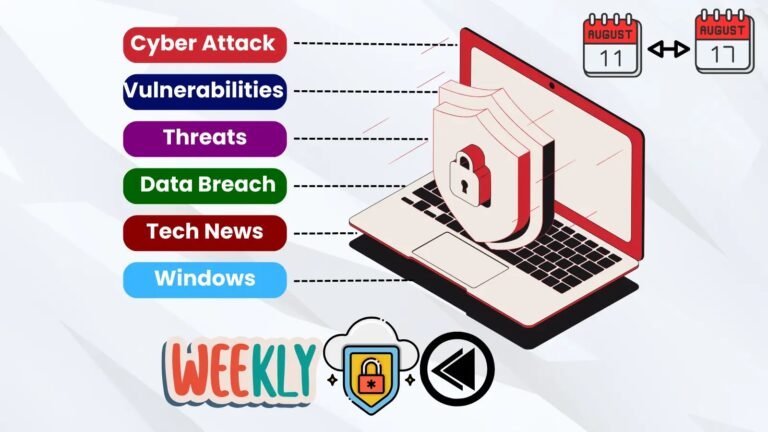Fast Facts
- Major vendors like Microsoft, Cisco, and Fortinet addressed critical vulnerabilities and released patches for over 100 security flaws, emphasizing the importance of prompt updates to prevent exploitation.
- Attackers employed sophisticated techniques—such as AI-generated phishing, clickjacking, and malware like SoupDealer and CastleLoader—to evade detection, target specific regions, and compromise enterprise and government systems.
- The week saw high-profile cyber incidents, including a breach of Canada’s House of Commons and widespread DDoS attacks, highlighting persistent state-sponsored and organized cyber threats.
- Growing AI capabilities have amplified cyber risks by automating attacks, enabling impersonation, bypassing authentication, and developing stealthy malware like SmartLoader, requiring enhanced multi-layered defense strategies.
Problem Explained
Between August 11 and 17, 2025, the cybersecurity landscape faced a tumult of sophisticated threats and urgent software patches, revealing an ongoing struggle to safeguard digital infrastructure. Major vendors like Microsoft and Cisco released critical updates—Microsoft patched over 90 vulnerabilities, including zero-day exploits in Windows and Office, while Cisco addressed flaws in IOS and NX-OS that risked denial-of-service attacks. Simultaneously, cybercriminals and nation-state actors intensified their campaigns: government systems such as Canada’s House of Commons were infiltrated via exploiting Microsoft vulnerabilities; new malware like DarkBit ransomware targeted virtualized environments; and phishing schemes leveraged AI-generated lures, remote control abuses, and spoofed alerts to deceive victims across sectors like healthcare, finance, and government. These incidents, reported by security agencies and tech firms, underscore a complex web of attacks fueled by AI, malware, and supply chain vulnerabilities, pressing organizations to prioritize patch management, behavioral monitoring, and threat intelligence to resist an increasingly cunning adversary.
Meanwhile, a proliferation of evolving cyber threats emerged, exploiting vulnerabilities in enterprise software, mobile devices, and network defenses. Cybercriminal groups such as CastleLoader and VexTrio launched widespread malware campaigns via phishing and malicious apps, often evading traditional detection through memory-only execution and AI-powered deception tactics. Nation-aligned threat actors like Curly Comrades deployed custom backdoors for long-term espionage, emphasizing targeted attacks on Eastern European governments. Additionally, vulnerabilities in tools like Ivanti, SAP, Fortinet, and Elastic EDR were actively exploited or patched, highlighting the critical importance of timely updates. These incidents, unveiled through government advisories and cybersecurity firms’ reports, illustrate the escalating role of AI not only as a tool for offense but also as a catalyst for more elusive, persistent attacks, making vigilant patching, user education, and advanced detection essential defenses in a landscape of intensifying digital peril.
Potential Risks
Between August 11-17, 2025, the cybersecurity landscape experienced a notable surge in sophisticated threats and critical vulnerabilities, underscoring the relentless nature of digital vulnerabilities. Major vendors like Microsoft and Cisco issued urgent patches addressing hundreds of flaws—including zero-day exploits in Windows, Office, IOS, and NX-OS—that could enable remote code execution, denial-of-service, or privilege escalation, thereby exposing enterprises to potential breaches. Concurrently, cybercriminals exploited these vulnerabilities through advanced techniques such as AI-generated phishing campaigns, remote control exploits in Microsoft Teams, and stealthy malware like SoupDealer, CastleLoader, and FireWood targeting diverse platforms including Linux, VMware, and Android devices. These threats are further amplified by AI’s role in automating and scaling attacks, from impersonation and reconnaissance to zero-day exploitation, making defenses increasingly challenging. Notable incidents include a breach of Canada’s House of Commons, targeted ransomware in healthcare sectors, and massive DDoS attacks, which collectively highlight how malicious actors leverage both vulnerabilities and emerging AI tools to compromise critical infrastructure, steal sensitive data, and disrupt services. This evolving environment demands heightened vigilance, swift patching, and sophisticated threat intelligence to mitigate potentially devastating impacts across sectors.
Possible Next Steps
Promptly addressing vulnerabilities in Microsoft, Cisco, and Fortinet security updates is critical to defending against cyber attacks, as these are essential components of many organizations’ digital defenses. Failing to act swiftly can lead to exploited weaknesses, data breaches, and operational disruptions.
Mitigation Measures
-
Regular Patching: Ensure timely installation of official security updates released by Microsoft, Cisco, and Fortinet.
-
Continuous Monitoring: Use intrusion detection and prevention systems to identify suspicious activities early.
-
Vulnerability Scanning: Conduct frequent scans to identify potential weaknesses in the network infrastructure.
-
Network Segmentation: Limit the spread of potential threats by dividing networks into isolated segments.
- Employee Training: Educate staff on cybersecurity best practices and recognizing phishing or social engineering tactics.
Remediation Steps
-
Incident Response Plan: Establish and regularly update a comprehensive plan to respond to security breaches.
-
System Isolation: Quickly isolate compromised systems to prevent lateral movement within the network.
-
Patch Rollback: In cases where updates cause issues, prepare procedures to revert to previous secure states.
-
Forensic Analysis: Conduct thorough investigations post-attack to understand breach vectors and improve defenses.
- Vendor Coordination: Collaborate with vendors for advanced support and tailored security updates after incidents.
Stay Ahead in Cybersecurity
Explore career growth and education via Careers & Learning, or dive into Compliance essentials.
Explore engineering-led approaches to digital security at IEEE Cybersecurity.
Disclaimer: The information provided may not always be accurate or up to date. Please do your own research, as the cybersecurity landscape evolves rapidly. Intended for secondary references purposes only.
Cyberattacks-V1

